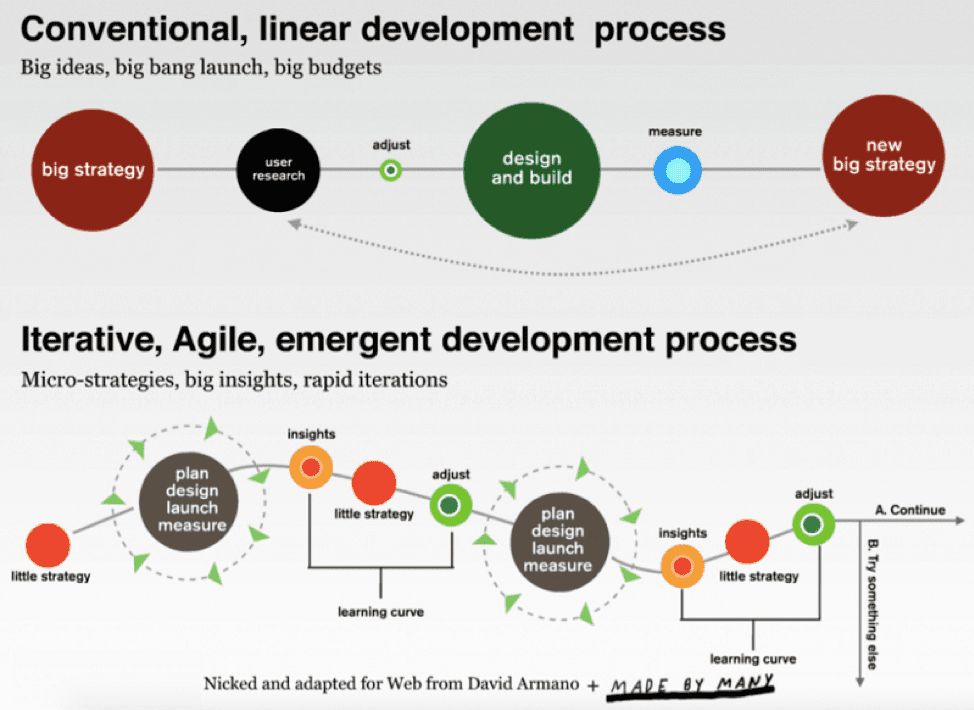Marketers can no longer afford to make 12-month marketing plans and review them annually. The agile approach of marketing enables them to review the performance of their campaigns every 2 weeks, recalibrate the process and iterate accordingly
There was a time when marketing was fairly simple. If you covered print, radio and television, your marketing campaign was in good shape. Marketing plans were made annually and were rarely changed.
With those simpler days gone, marketing is evolving at a supersonic pace. Most marketers still work on quarterly plans. However, in this digital world, a lot of change happens in 90 days. Marketing teams need to respond accordingly.
For example, team one measures, iterates and recalibrates their process every two weeks instead of a quarter.
Team two only adjusts their plan every quarter.
Team one is 543% faster and delivers 6x more often.
Sounds efficient, right?
While agile methods deliver at this rate, traditional marketing won’t allow you to reach this level. You will have to adopt an agile marketing methodology.
Download our Business Resource – Growth hacking guide
This guide aims to show how growth hacking concepts can be applied to established medium and large businesses.
Access the Growth hacking guide
What is the Agile Approach to Marketing?
Inspired by the agile software development methodology, an agile approach to marketing allows online businesses to adjust their marketing strategy according to the latest changes in the market to reach potential customers quickly.
This approach involves planning, executing, measuring, and reiterating your marketing strategy with the focus on frequent releases, deliberate experimentation, and unending commitment towards customers’ satisfaction.
If you’re a marketer who wants to know how exactly the agile approach can play out in your marketing department, this short guide will give you everything there is to know about agile marketing including benefits, examples, key elements, common Q&As, and mistakes to avoid while implementing this approach.
Grow your business and professional marketing skills
Rapidly gain the skills to reach and convert more customers with 30% off RACE Framework training
Find My Plan
Benefits of Agile Marketing over Traditional Marketing
In simple terms, an agile approach helps marketing teams to work smartly and more effectively to produce better and clearer results than traditional marketing methods.
The benefits of the
agile approach over traditional marketing are:
1. Increased productivity
Agile marketing teams get between 30% and 40% more done compared to traditional marketing teams. The two reasons attributed to this are the fact that they do less reworking and that they are working on the right priorities.
2. Transparency
The agile approach achieves transparency in two separate ways. Firstly, it allows sales, operations, and management to clearly see what the marketing team is working on.
Secondly, it encourages the marketing team to engage closely with customers and create a high degree of honesty to satisfy those customers.
3. Measurability
The marketing teams run small experiments, measure results and then focus on the strategies that have worked. This way, the team can better manage content creation, distribution and promotion to yield better results.
This image shows a detailed statistical breakdown of the benefits of adopting an agile marketing approach.

Case studies of successful agile marketing implementation
1. SEMrush
The online visibility management and content marketing SaaS platform encourages its marketing department to be agile at all levels. With a flat structure, SEMrush empowers the teams to control over how to do the jobs that management deems necessary.
Daily standup meetings ensure that people are staying on track and the trust placed in each team member encourages involvement from everyone. Sprints enable the teams to experiment rapidly, measure the results and learn on a continuous basis. Simultaneously, the teams are at liberty to remove people who aren’t contributing.
The result: As mentioned by Olga Adrinko, SEMrush’s Global Head of Marketing on a podcast, the average revenue growth year over year from new markets was greater than 90%. The company gained 500,000 new users in eight months.
2. Santander
The UK based Santander, a consumer finance brand realized that the traditional marketing cycles of lengthy review cycles weren’t working for them anymore. They adopted an agile approach by releasing low-risk campaigns in two-week sprints. The successful campaigns got more budget while the unsuccessful ones were abandoned.
The takeaways, in terms of statistics reported by MarketingWeek, were:
- Loyalty to the brand increased by 12%.
- The Net Promoter Score (NPS) was at an all-time high in 17 years.
- Account satisfaction in terms of trust and advocacy increased by 10%.
- Positive sentiment was 90%, the highest they ever received.
3. Northern Arizona University
The university had a traditional four-member team creating an annual budget based on the goals and designing specific marketing projects. With the help of agencies, they would create around 50 pieces of collaterals every year.
Then, the digital wave started. Despite multiple rejigs, they were unable to keep up with client demands. Their Director of Strategic Marketing, Ann Marie deWees discovered agile marketing. They structured two-week sprints instead of having individuals take up entire projects.
They collaborated with the IT team to create a designer group instead of relying on external contractors. With this approach, they would break down projects into smaller pieces and distribute them among members based on their skills and availability. This way, they would get projects done within two weeks rather than having to wait for the collaterals to come back, get edited, revised, and finally go live.
The takeaways, as published by UniversityBusiness include:
- Content production increased from 50 pieces to 200 pieces (400%) in the first year.
- Completion rate of sprint tasks was 95%.
- 20% cost saving.
- Client satisfaction increased by 30% in six months.
4 key elements of agile marketing
These four key elements will help you take a deep dive into agile marketing:
1. Having a strategic vision
Crucial to a business, a strategic vision allows you to break down a long-term plan into yearly, quarterly, monthly, weekly (and sometimes daily) plans to meet your major business goals.
In simple words, don’t be married to your long-term plans. Instead, pivot and adjust as and when necessary to identify the best way to serve your customers.
Your marketing strategy must be flexible and adaptive.
2. Experiment deliberately
In agile marketing, strategies are adopted based on experiments done by making small changes, testing them over a small period of time and analyzing the results.
This cycle runs on loop until you have a well-defined marketing strategy that generates the desired results.
Agile marketing means always testing, iterating and improving.
3. Data-based action aligned with business goals
Data helps marketers to decide on the next experiment. But the problem with marketing is, there are so many different kinds of data, such as traffic, social media shares, email campaigns, and so on.
So, how does a business ensure that its marketing team is not focusing on the wrong type of data?
Choose the right Key Performance Indicators (KPI’s) based on your business goals and measure the progress towards those goals.
4. Fast approval process
Agile marketing is a fast-paced approach to content creation, distribution, lead generation, and conversion. But, when businesses adopt agile for the first time, they often always hit one of the biggest roadblocks to fast implementation, a complicated approval process.
I’ve personally witnessed how agile strategy has failed for many businesses due to their long & complicated approval processes.
McKinsey shared a perfect example of an international bank that wanted to experiment with a new email offer through an agile approach. Their marketing team put together a mailing list, wrote the copy, designed the template and send it to their legal team to get the required approvals.
After eight weeks, they got the approval and they sent out the email.
Result? - The whole test became irrelevant due to the eight week wait time.
Set clear expectations by conveying the deadlines whenever you need approvals.
Enhance your team's marketing skills
Review and apply our free templates to create employee development plans
Get your free template
Common mistakes to avoid while adopting an agile approach
The agile approach will definitely make a huge impact on your marketing results. However, be careful of some of the old habits that might ruin the effectiveness of the agile approach. Here are the three common mistakes you must avoid while implementing agile marketing.
1. Don’t make large bets
The traditional marketing approach is about coming up with a big plan and working towards it with the hope of yielding good results one day. In agile marketing, you can still achieve a plan like this with a focus on small wins and iterate based on data to reach the big goal.
2. Never stick to a specific plan
Agile marketing brings results when you keep your strategy flexible. In fact, 54.8% of surveyed marketers have reported that changing gears quickly has been the biggest benefit of going agile.
Be open to new ideas and experiment with them, even if it means rewriting the milestones or reassigning the tasks to other team members.
3. Don’t let your "gut-feeling" guide your marketing strategy
Old-school marketers often ran campaigns based on instincts. But in agile marketing, the idea is validated on the basis of data, not gut-feeling.
Data must be the driving force of your marketing strategy. Your team works towards measurable goals. Data allows marketing strategies to evolve and leads to the discovery of newer, quicker and more efficient ways of reaching potential customers.
Conclusion
While traditional marketing is predictive, sequential and rigid, the agile approach is adaptive, iterative and flexible. Agile is well-suited for the marketing domain, which is fast-paced and dynamic.
Chandresh Patel is the CEO and MD of
Bacancy Technology. Their team of 200+ agile developers creates agile methodologies for startups and enterprises. Some of their clients include RedBull, Mercedes-Benz, Disney and Renault. Follow them on
Twitter.












